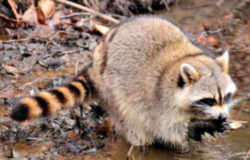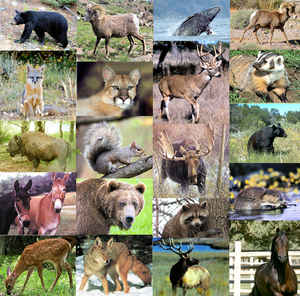
Tennessee Symbols
Tennessee State Wild Animal
Raccoon

(Procynn lotor)
Adopted in 1972.
By House Joint Resolution 156, the 87th General Assembly adopted the raccoon, (Procynn lotor,) as Tennessee's wild animal in 1972. The raccoon, Procynn lotor, is a furry animal that has a bushy, ringed tail and a band of black hair around its eyes which looks like a mask. Raccoons, often called coons, eat fish and frogs that they catch in rivers and streams. Raccoons living in Tennessee measure from 30 to 38 inches long, including their tails. They weigh from 12 to 25 pounds. Most males are larger than females. Raccoons walk like bears, with all four feet on the ground, and are good swimmers.
Tennessee State Wild Animal: Raccoon

Raccoons are small, very adaptable mammals from North and South America and a few tropical islands. They live in a variety of habitats, including marshes, forests, prairies, cities, and suburbs. These nocturnal (most active at night) animals have a life span of about 6 years or so in the wild.
Characteristics of the Raccoon
Anatomy
Raccoons are easily recognized by their grayish, salt-and-pepper bodies with a black mask over the eyes and rings around the tail. Often these rings are less defined on the underside of the tail. The fur is long and soft with dense underfur in the winter and thick guardhair on the back and around the tail at all times of the year. Young are colored similarly to adults, except that the top of the head, nape of the neck, and area behind the ears are brownish black, whereas these areas on adults are lighter. In general, the more northern raccoons have longer and darker coats. They have a bushy, black-ringed tail, clawed feet, and a pointed snout. They have long fingers and toes and an acute sense of touch. The hind legs and feet are generally dark brown to black. There are five digits on each foot, each with a non-retractile claw. The raccoon leaves a distinct hand-like print on soft ground that can occasionally show the individual toes. Newborn raccoons do not have black eye patches or a ringed tail; these develop after a few days. Raccoons grow to be about 18 to 26 inches (46-66 cm) long plus a striped, furry tail 9 to 12 inches (23-30 cm) long.
Females have six mammae, arranged in three pairs in the pectoral, abdominal, and groin areas. Males have a long, curved baculum.
Raccoons generally live ten years or more in the wild and may live even longer in captivity. The oldest known raccoon was a female aged 12 years and
7 months at death.
Diet
Raccoons will eat almost anything including nuts, fruits, berries, grass, leaves, seeds, insects, crustaceans, worms, eggs, fish, some small mammals, kitchen scraps, and garbage. Raccoons will even get into trash cans and live primarily off food scraps found there. Raccoons find much of their food in water.
Reproduction
In the eastern United States, raccoons mate in February and March, and the young are born in April and May after a gestation period of 63-70 days.
There are generally two to seven young per litter, and the average litter contains four young. Although the young are covered with hair at birth, their
eyes do not open for about nineteen days. The young are weaned at about six weeks but remain with their mothers into the autumn. Some young remain
with their mothers until the next breeding season. Raccoons reach adult size and sexual maturity around two years of age. Some may mate before they
reach maturity, but these matings rarely produce offspring.
The raccoon has a bipart uterus, with two full uterine horns. Trans-uterine migration occurs in the raccoon where embryos conceived from the eggs produced
in one ovary migrate to the uterine horn on the opposite side. Trans-migration allows the raccoon to support more embryos in the uterus. Also, ovulation
in raccoons does not occur until after copulation. This characteristic is advantageous because raccoons do not waste metabolic energy on ovulation
until mating has actually occurred.
Habitat
In the wild, raccoons are found primarily along streams and lakes near wooded areas. However, raccoons are opportunists and may inhabit urban, residential, and recreational areas. Raccoons are not particular about den sites and may use tree hollows, hollow logs, caves, rock crevices, holes in the ground, and sometimes even storm sewers.
Raccoons are nocturnal, though they may leave their dens during the day to bask in the sun or forage for food. The home range of an adult male may be as large as 3.2 km (2 mi.) And as small as 18.2 hectares (45 acres), with an average range of 204 hectares (504 acres). It is estimated that female and juvenile ranges are approximately half this average size. In suburban areas, home ranges seldom exceed 3.2 hectares (8 acres).
TENNESSEE HOUSE JOINT RESOLUTION NO. 156
Tennessee General Assembly on May 17, 1971 and by Governor Winfield Dunn on May 21, 1971.
HOUSE JOINT RESOLUTION NO. 156
By Neese
A RESOLUTION to proclaim the Raccoon (Procyon lotor) as the Official Wild Animal of the State of Tennessee.
WHEREAS, The Raccoon (procyon lotor) is in great abundance throughout the entire State of Tennessee; and
WHEREAS, The Raccoon is considered to be one of our most important fur bearing game animals; and
WHEREAS, The Raccoon is held in high esteem as one of the most valuable game animals in the State of Tennessee; and
WHEREAS, The "Coonskin Cap" has been displayed in the Halls of Congress and on the Frontier with equal candor; and
WHEREAS, Most small boys, and men alike, this Nation over think of the Great State of Tennessee as: Home hunting ground of Davy Crockett, Green Mountains,
and 'Coons; and
WHEREAS, Without the sport of 'Coon hunting, many rich and colorful stories would never have been possible, to be related from one generation to another
for centuries to come; and
WHEREAS, The 'coon is a subject of great deal of legislation in each General Assembly; and[sic]
WHEREAS, Without the sport of 'Coon hunting, many men would have missed the envigorating benefits and enriching experiences to be enjoyed while pursuing
the elusive 'Coon; and
WHEREAS, The State of Tennessee does not officially have a State Wild Animal; now, therefore,
BE IT RESOLVED BY THE HOUSE OF REPRESENTATIVES OF THE EIGHTY-SEVENTH GENERAL ASSEMBLY OF THE STATE OF TENNESSEE, THE SENATE CONCURRING, That the Raccoon
(Procyon lotor) be adopted as the official wild animal symbolic of the State of Tennessee.
Tennessee Law
The official wild animal of the State of Tennessee was adopted by House Joint Resolution and is, therefore, not recorded in the Tennessee Code Annotated
Taxonomic Hierarchy: Raccoon
Kingdom: Animalia
Phylum: Chordata
Class: Mammalia
Order: Carnivora
Family: Procyonidae
Genus: Procyon
Species: P. lotor







